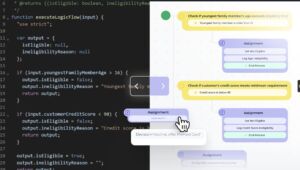When software fails, it’s often not the code that’s broken—it’s the understanding behind it. Ownership of logic is scattered across tickets, docs, and conversations, leaving teams with mismatched assumptions and costly rework. The real bottleneck in software development isn’t writing code; it’s building shared understanding of how the system should work.
When software fails, the root cause isn’t always a bug in the code.
Sometimes, the code does exactly what it was told to do.
The problem is that what it was told to do wasn’t right.
In other words, the logic was wrong.
And that’s not just a developer problem. It’s a shared problem across the entire team.

In most organizations, “owning the logic” is messy.
In reality, nobody fully owns it. The logic lives in fragments. A Jira ticket here, a conversation there, a diagram buried in a shared drive, and ultimately, in the minds of individual people.
When those fragments get stitched together into code, what you end up with isn’t the logic you thought you agreed on; it’s the logic that survived the translation process.
Every handoff introduces a chance for the logic to drift.
At each step, small mismatches accumulate: a missed edge case, an assumed default, an interpretation of “accurate” that actually means “accurate enough.”
This translation tax slows teams down, creates rework, and erodes trust between roles. By the time the feature ships, the logic may be technically correct but misaligned with the original intent.
AI-assisted coding tools speed up the “code-writing” part of the process, but that’s only a fraction of the journey.
Think about how software gets made today:
By the time the domain expert sees their idea in a working product, an entire cycle has passed. If the idea wasn’t perfect to begin with (and most aren’t), the only way to improve it is to run through the whole cycle again. That takes ages.
AI code generators don’t change this dynamic. They accelerate the developer’s slice of the process, but they don’t remove the handoffs that cause delay, misalignment, and rework. The result? You can still end up with code that perfectly implements the wrong thing, only now you got there faster. It’s a faster path to the same dead end.
What’s missing is a common understanding before code ever gets written.
When you strip away the tools, the sprints, and the methodologies, the real bottleneck in software development is this:
Alignment: Does everyone, from the domain expert to the senior engineer, have the same understanding of how the system should work?
If the answer is “kind of,” you have a problem. Because partial understanding leads to partial correctness, and partial correctness is just a bug with good intentions.
Leapter flips the ownership problem on its head.
Instead of treating logic as something that gets passed down a chain of command, we make it a shared artifact from the very start.
The result isn’t a ticket. It’s an executable blueprint — a structured, visual representation of the logic that everyone can see, understand, and agree on.

And here’s the real bonus: the process gets dramatically faster.
No more moving a requirement from a Word doc to a Jira ticket to a developer backlog to QA before the original idea is validated. With Leapter, domain experts can “play” with their ideas directly in a working system, test assumptions in real time, and iterate quickly without waiting for a full development cycle.
Shared understanding doesn’t just prevent misunderstandings. It eliminates the drag of handoffs by turning what used to take weeks into something that can happen in days, or even hours.
When teams share true ownership of the logic:
And here’s the reality: getting to that shared understanding always takes work. For complex projects, it’s the lion’s share of the effort. There’s no shortcut. The best teams know this and make alignment a priority. The worst teams ignore it and pay for it later.

In fact, this was at the heart of the agile movement: improving communication and creating shared understanding. But agile often relies on scattered artifacts like extra workshops, sticky-note diagrams, and endless tickets, that keep the conversation alive but rarely serve as a single source of truth.
Leapter makes this alignment the default. Instead of a fragile patchwork of documents, diagrams, and whiteboards, teams get a structured, shared blueprint that everyone can see, refine, and own together.
Code is only as good as the logic behind it.
And logic is only as good as the team’s shared understanding of it.
If you want to ship faster, reduce rework, and build systems you can trust, stop thinking about who “owns” the logic, and start thinking about how you make it visible, verifiable, and shared.
That’s what Leapter does.
... let's celebrate!!!